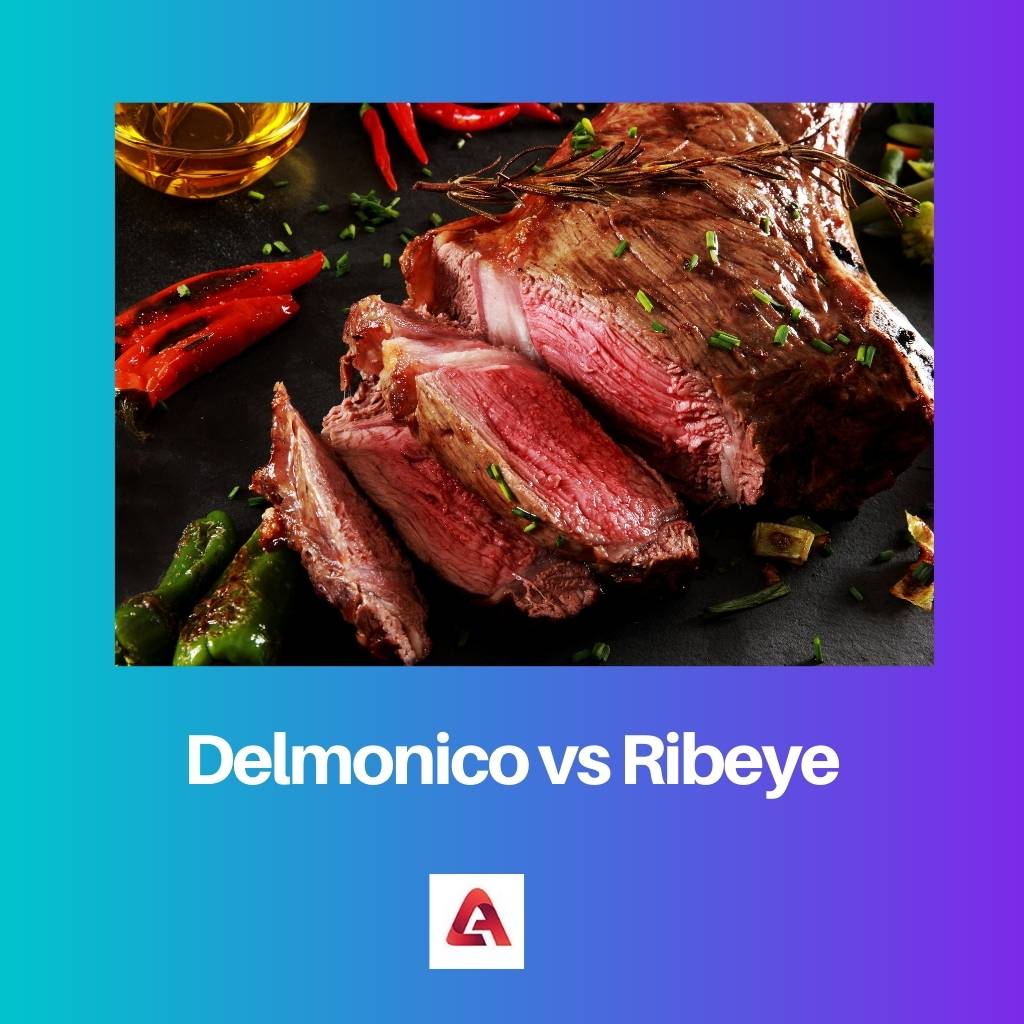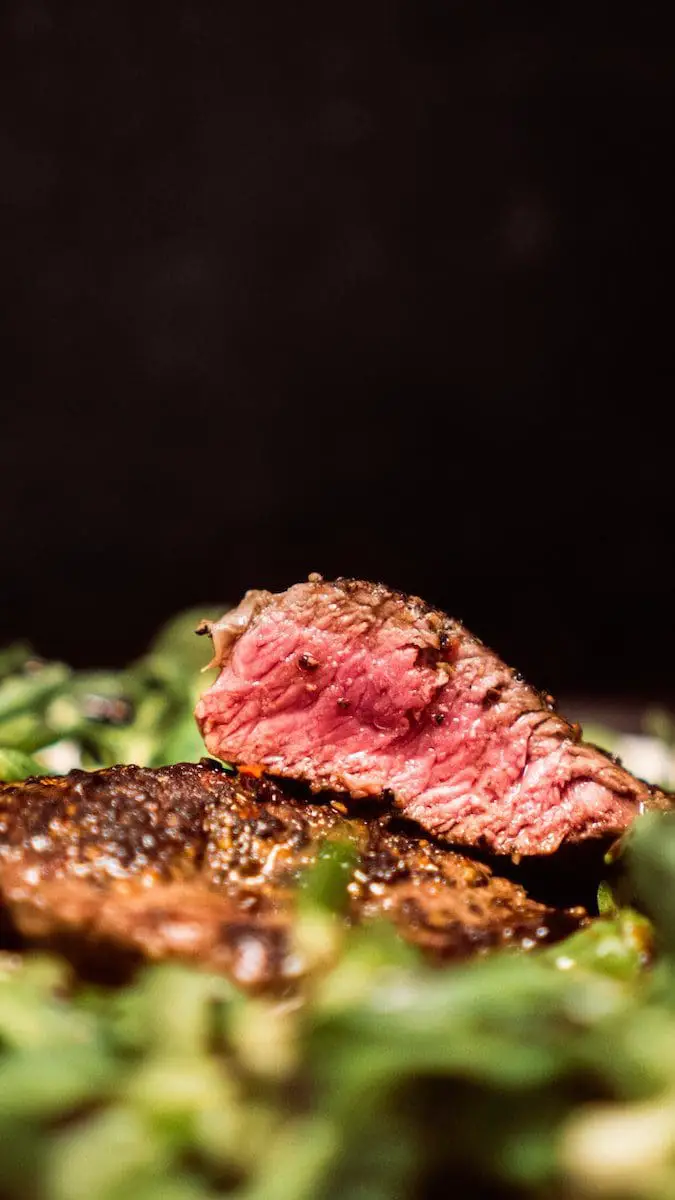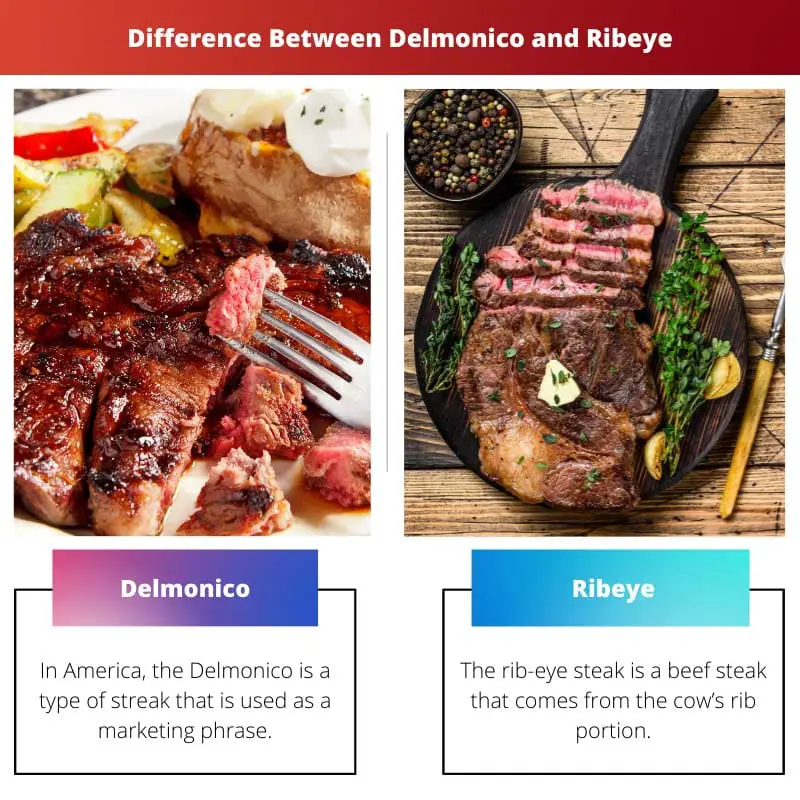Steak aficionados may be found all around the world, even in America. In a typical American restaurant, there are over a dozen different sorts of steaks. Here, we’ll distinguish between the two most well-known sorts of steaks, Delmonico and Ribeye.
Key Takeaways
- Delmonico steak is cut from the ribeye roast, while ribeye steak is cut from the rib area of the cow.
- Delmonico steak is boneless, while ribeye steak may or may not have a bone.
- Delmonico steak is known for its tenderness and buttery flavor, while ribeye steak is known for its rich, beefy flavor and marbling.
Delmonico vs Ribeye
The difference between Delmonico and Ribeye is that Delmonico’s texture is rough. Therefore it requires a lot of cooking and marination to get a good flavor. However, on the contrary, Ribeye is naturally full of flavors, as it is obtained from the rib part of the cow. Thus it does not need any proper marination techniques before cooking.

Delmonico was named after a popular late-eighteenth-century restaurant in New York City. Delmonico can be cut from any area of the cow and comes in a variety of cuts. Delmonico is less pricey and more easily accessible.
The fat cover is common in Delmonico. Before cooking, these fat coverings are trimmed. Bone-in or boneless Delmonico is available. Delmonico isn’t particularly flavorful. Thus it necessitates marination with vinegar.
Ribeye is named after the section of the cow’s rib that is used in its preparation. Ribeye is a cut of beef that includes the cow’s meat. Ribeye is more soft and juicy than other cuts of meat. Ribeye is an extremely costly cut of meat.
There is no fat layer in the ribeye. Ribeye is boneless meat since it is devoid of bones. Because ribeye is naturally flavorful, it does not require marination or any additional flavors.
Comparison Table
| Parameters of Comparison | Delmonico | Ribeye |
|---|---|---|
| Source of name | A popular restaurant in New York City. | Due to its usage, the cow’s rib part. |
| Cuts involved | Various types of cuts can be taken from any part of the cow. | The flesh of the cow has rib cuts. |
| Texture | Tough texture requires intense cooking, proper marination. | Juicier and tender. |
| Price range | Affordable, less expensive. | More expensive. |
| Fat cover | It contains a fat cover but is removed before cooking. | Does not contain any type of layer of fat. |
| Bone or boneless | It can be bone meat or boneless meat. | Does not contain bones, boneless meat. |
| Flavours | Not much flavourful requires vinegar and marination. | Naturally flavourful. |
What is Delmonico?
In America, the Delmonico is a type of streak that is used as a marketing phrase. It is utilized in conjunction with various meat preparations. It has nothing to do with a certain recipe or the meat portion of a specific region.
Delmonico can refer to a variety of steaks made from various regions of the cow’s body, all of which are prepared using various procedures or processes.
Delmonico was named after a prominent New York City restaurant towards the end of the eighteenth century. Delmonico can be made from any area of the cow and comes in a variety of cuts. Delmonico’s rough texture necessitates intensive cooking and appropriate marination for a greater flavor.
Delmonico is frequently less pricey and more accessible. Delmonico has a fat cover. Before cooking, the fat coverings are reduced. Delmonico is available with or without bones. Delmonico isn’t particularly flavorful. Thus it necessitates the use of vinegar and marination.

What is Ribeye?
The rib-eye steak is a beef steak that comes from the cow’s rib portion. This particular cut of meat is more soft and juicy than the rest of the animal. Because the rib section of the cow is the fattest, richest, and beefiest, the steak derived from it is one of the most appetizing cuts for meat-eaters.
Ribeye gets its name from the fact that it is made from the ribs of a cow. Ribeye is a cut of beef that includes the cow’s meat as well as rib cuts. Ribeye is more soft and juicy.
Ribeye is a pricey cut of meat. Ribeye does not have a layer of fat on it. Ribeye is boneless meat because it does not contain any bones.
Ribeye is naturally flavorful and does not require marination or any additional flavors. Because the meat obtained from this muscle is juicier and tender than that obtained from other muscles, it can be prepared merely by grilling without the addition of vinegar.

Main Differences Between Delmonico and Ribeye
- Delmonico got its name from a popular restaurant in New York City during the end of the eighteenth century. On the other hand, Ribeye got its name due to its usage, which is the cow’s rib part.
- Delmonico includes various types of cuts and can be taken from any part of the cow. On the other hand, Ribeye includes the flesh of the cow and has rib cuts.
- Delmonico requires intense cooking with proper marination for a better taste, as its texture is tough. On the other hand, Ribeye is juicier and tender.
- Delmonico is easily affordable and less expensive. On the other hand, Ribeye is highly expensive.
- Delmonico contains fat cover. These fat covers are cut down before cooking. On the other hand, Ribeye does not contain any type of layer of fat.
- Delmonico can be bone meat or boneless meat. On the other hand, Ribeye does not contain bones. Hence they are boneless meat.
- Delmonico is not much flavourful. Hence it requires vinegar and marination. On the other hand, Ribeye does not require marination or any other flavors, as it is naturally flavourful.

- https://www.sciencedirect.com/science/article/pii/S0309174013003677
- https://books.google.com/books?hl=en&lr=lang_en&id=ARngRJBxjlMC&oi=fnd&pg=PP1&dq=Difference+Between+Delmonico+and+Ribeye+(With+Table)&ots=n–hITuj9H&sig=YU10JNhg6uGGqlFALUdHrVGCVDI

The thorough explanation of the differences in texture, price, and flavors of Delmonico and Ribeye steaks is highly informative. The historical background and significance of the names add to the intriguing details provided in the article.
I couldn’t agree more with Lisa93. The article provides a detailed understanding of Delmonico and Ribeye, covering various aspects from texture to origin, making it an insightful read.
Remarkably interesting article to learn about the differences between two famous types of steak, Delmonico and Ribeye. Gives a clear understanding of the cuts, flavors, and textures of each type.
Absolutely, the article provides very useful information for steak lovers. It’s great to know the name origins and the different flavors and textures of Delmonico and Ribeye steak.
The article provides a comprehensive analysis of the differences between Delmonico and Ribeye steaks, including a detailed comparison table. A fascinating read for steak enthusiasts.
Absolutely, the in-depth analysis and comparison table make it easier to distinguish between Delmonico and Ribeye steaks. It’s a must-read for those interested in steak varieties.
The article gives a comprehensive overview of the differences between Delmonico and Ribeye steaks. It’s fascinating to learn about the history of Delmonico and the natural flavors of Ribeye steak.
I agree, the historical background of Delmonico and the natural flavors of Ribeye are particularly intriguing. The article provides valuable insights into the world of steak cuts and flavors.
This article presents a well-researched comparison between Delmonico and Ribeye steaks. The detailed explanation of the differences in texture, flavors, and price range is highly educational.
Indeed, the comparison is quite enlightening. The information about the varying textures and price ranges of Delmonico and Ribeye provides a holistic understanding of these two popular steaks.
The article provides valuable insights into the distinct characteristics of Delmonico and Ribeye steaks. The detailed comparison table facilitates a clear understanding of the differences between these two popular steak cuts.
Well said, Marshall. The comprehensive information and the clear differentiation between Delmonico and Ribeye in the article are impressive and informative.
This article is a rich source of information for anyone interested in the differences between Delmonico and Ribeye steaks. The comprehensive details provided give a clear picture of the unique characteristics of each type.
I couldn’t agree more, Jbell. The article’s detailed analysis and the clear comparison table offer a deep understanding of Delmonico and Ribeye steaks. It’s a compelling read for steak enthusiasts.
The detailed comparison between Delmonico and Ribeye steaks in this article is educational and insightful. It provides a comprehensive understanding of the origins, textures, and flavors of these two steak varieties.
I second that, Jim Mason. The article offers a wealth of knowledge about the unique characteristics of Delmonico and Ribeye, making it an engaging and informative read.
The historical significance and detailed comparison of the characteristics of Delmonico and Ribeye steaks make this article an enlightening read. The culinary background and flavor profiles are intriguing.
Absolutely, Jacob. The article offers a comprehensive understanding of the origins and culinary aspects of Delmonico and Ribeye steaks, catering to those interested in the finer details of steak varieties.
This article is a treasure trove of information on the distinctions between Delmonico and Ribeye steaks. The details provided are thorough and enlightening, making it an excellent source of knowledge for steak connoisseurs.
Absolutely, Helen Davies. The article’s extensive research and insights into the individual characteristics of Delmonico and Ribeye make it a valuable resource for those intrigued by steak varieties.